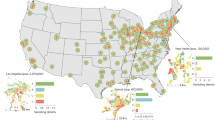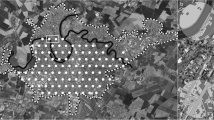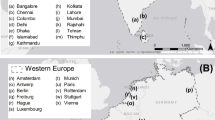Abstract
Anthropogenic change, specifically urbanization, has lasting impacts on biodiversity and ecosystem services. Past work has linked green space variables and socioeconomic characteristics with biodiversity in urban areas. Shrinking cities present an interesting case for studying biodiversity because many of these places have implemented demolition policies to remove vacant buildings from the landscape, which returns previously urbanized land back into a “natural” state. The objective of this study is to investigate the multifaceted relationship among urban green space, socioeconomic characteristics, demolition activities, and avian species richness in the shrinking city of Buffalo, NY. We first establish a baseline understanding of how social and ecological factors are related to avian species richness through generalized linear models (GLM) and then incorporate a variable characterizing demolition to understand how the process of demolition may be impacting species richness relative to other factors. Second, since our analysis relies on “citizen science” data from eBird, we aim to better understand the factors driving eBird participation in Buffalo through zero-inflated negative binomial (ZINB) regression models to test how social and ecological characteristics and demolition affect checklists submission across the city. Our findings suggested that demolition activities do not increase species richness in Buffalo, indicating these sites may not be returning to a natural state that is usable by birds. We also found that areas that have undergone considerable demolition may be a potential deterrent to eBird participation, and eBird users may create bias by sampling areas with greater green space connectivity, and thus higher richness.


Similar content being viewed by others
References
Anderson D (2001) Model based inference in the life sciences: a primer on evidence. Springer, New York
Arnfield A (2003) Two decades of urban climate research: a review of turbulence, exchanges of energy and water, and the urban heat island. Int J Climatol 23:1–26
Baker L, Brazel A, Selover N, Martin C, McIntyre N, Steiner F, Nelson A, Musacchio L (2002) Urbanization and warming of Phoenix (Arizona, USA): impacts, feedbacks, and mitigation. Urban Ecosyst 6:183–203
Battisti C, Fanelli G (2016) Applying indicators of disturbance from plant ecology to vertebrates: the hemeroby of bird species. Ecol Indic 61:799–805
Bernstein L, Jin X, Gregor B, Adler-Golden S (2012) Quick atmospheric correction code: algorithm description and recent upgrades. Opt Eng 51:111719
Beveridge C (2002) Olmsted - his essential theory. Nineteenth Cent 20:32–37
Bischof H, Shneider W, Pinz A (1992) Multispectral classification of Landsat-images using neural networks. IEEE T Geosci Remote 30:482–490
Blair R (1996) Land use and avian species diversity along an urban gradient. Ecol Appl 6:506–519
Boakes E, McGowan P, Fuller R, Chang-qing D, Clark N, O’Connor K, Mace G (2010) Distorted views of biodiversity: spatial and temporal bias in species occurrence data. PLoS Biol 8:e1000385
Boakes E, Gliozzo G, Seymour V, Harvey M, Smith C, Roy D, Haklay M (2016) Patterns of contribution to citizen science biodiversity projects increase understanding of volunteers’ behaviour. Sci Rep 6:33051
Bolker B (2014) bbmle: tools for maximum likelihood estimation. R package version 1.0.17. https://CRAN.R-project.org/package=bbmle. Accessed 18 April 2016
Brooks T, Mittermeier R, Mittermeier C, da Fonseca G, Rylands A, Konstant W, Flick P, Pilgrim J, Oldfield S, Magin G, Hilton-Taylor C (2002) Habitat loss and extinction in the hotspots of biodiversity. Conserv Biol 16:909–923
Buffalo Olmsted Parks Conservancy (2016) Your Olmsted Parks. https://www.bfloparks.org/. Accessed 11 April 2016
Burkholder S (2012) The new ecology of vacancy: rethinking land use in shrinking cities. Sustainability 4:1154–1172
Burnham K, Anderson D (2001) Kullback-Leibler information as a basis for strong inference in ecological studies. Wildl Res 28:111–119
Burnham K, Anderson D, Huyvaert K (2011) AIC model selection and multimodel inference in behavioral ecology: some background, observations, and comparisons. Behav Ecol Sociobiol 65:23–35
Caliman A, Carneiro L, Leal J, Farjalla V, Bozelli R, Esteves F (2013) Biodiversity effects of ecosystem engineers are stronger on more complex ecosystem processes. Ecology 94:1977–1985
Callaghan C, Gawlik D (2015) Efficacy of eBird data as an aid in conservation planning and monitoring. J Field Ornithol 86:298–304
Chapin F, Schylze E, Mooney H (1992) Biodiversity and ecosystem processes. Trends Ecol Evol 7:107–108
Collier C (2006) The impact of urban areas on weather. Q J R Meteorol Soc 132:1–25
Cooper C, Dickinson J, Phillips T, Bonney R (2007) Citizen science as a tool for conservation in residential ecosystems. Ecol Soc 12:11–21
Costanza R, d’Arge R, deGroot R, Farber S, Grasso M, Hannon B, Limburg K, Naeem S, ONeill R, Paruelo J, Raskin G, Sutton P, van den Belt M (1997) The value of the world’s ecosystem services and natural capital. Nature 387:235–260
Cumming G, Buerkert A, Hoffmann E, Schlecht E, von Cramon-Taubadel S, Tscharntke T (2014) Implications of agricultural transitions and urbanization for ecosystem services. Nature 515:50–75
DAFPU: Department of Administration, Finance, Policy and Urban Affairs, City of Buffalo, Janet Penksa Commissioner (2007) Moving Buffalo forward: policy briefs from the Brown administration 1:1–4 https://www.ci.buffalo.ny.us/files/1_2_1/Mayor/PublicPolicyPublication/5in5_DemoPlan.pdf. Accessed 12, April 2017
Dallimer M, Irvine K, Skinner A, Davies Z, Rouquette J, Maltby L, Warren P, Armsworth P, Gaston K (2012) Biodiversity and the feel-good factor: understanding associations between self-reported human well-being and species richness. Bioscience 62:47–55
Davis A, Belaire A, Farfan M, Milz D, Sweeney E, Loss S, Minor E (2012) Green infrastructure and bird diversity across an urban socioeconomic gradient. Ecosphere 3:A105
Delmelle E (2015) Five decades of neighborhood classifications and their transitions: a comparison of four US cities, 1970-2010. Appl Geogr 57:1–11
eBird Basic Dataset (2015) Version: EBD_relNOV-2015. Cornell Lab of Ornithology, Ithaca
Eigenbrod F, Bell V, Davies H, Heinemeyer A, Armsworth P, Gaston K (2011) The impact of projected increases in urbanization on ecosystem services. Proc R Soc Lond B 278:3201–3208
Erlich P, Wilson E (1991) Biodiversity studies: science and policy. Science 253:758–762
ESRI (2014) ArcGIS desktop: release 10.2. Environmental Systems Research Institute, Redlands
Estoque R, Murayama Y (2014) Measuring sustainability based upon various perspectives: a case study of a hill station in Southeast Asia. Ambio 43:943–956
Evans C, Abrams E, Reitsma R, Roux K, Salmonsen L, Marra P (2005) The neighborhood Nestwatch program: participant outcomes of a citizen-science ecological research project. Conserv Biol 19:589–594
Fernandez-Juricic E (2000a) Density dependent habitat selection of corridors in a fragmented landscape. Ibis 143:278–287
Fernandez-Juricic E (2000b) Bird community composition patterns in urban parks of Madrid: the role of age, size, and isolation. Ecol Res 15:373–383
Fernandez-Juricic E (2001) Avian spatial segregation at edges and interiors of urban parks in Madrid, Spain. Biodivers Conserv 10:1303–1316
Frazier A, Bagchi-Sen S (2015) Developing open space networks in shrinking cities. Appl Geogr 59:1–9
Frazier A, Bagchi-Sen S, Knight J (2013) The spatio-temporal impacts of demolition land use policy and crime in a shrinking city. Appl Geogr 41:55–64
Gaston K (1995) Biodiversity: loss. Prog Phys Geogr 19:255–264
Gaston K, Blackburn T, Goldewijk K (2002) Habitat conversion and global avian biodiversity loss. Proc R Soc Lond B 270:1293–1300
Gould W (2000) Remote sensing of vegetation, plant species richness, and regional biodiversity hotspots. Ecol Appl 10:1861–1870
Grove J (1997) A social ecology approach and applications of urban ecosystem and landscape analyses: a case study of Baltimore, Maryland. Urban Ecosyst 1:259–275
Grove J, Troy A, O’Neil-Dunne J, Burch W, Cadenasso M, Pickett S (2006) Characterization of households and its implications for the vegetation of urban ecosystems. Ecosystems 9:578–597
Haase D (2008) Urban ecology of shrinking cities: an unrecognized opportunity? Nature Cult 3:1–8
Hand L, Shepherd J (2009) An investigation of warm-season spatial rainfall variability in Oklahoma City: possible linkages to urbanization and prevailing wind. J Appl Meteorol Climatol 48:251–269
Hilborn R, Mangel M (1997) The ecological detective: confronting models with data. Princeton University Press, New Jersey
Hollander J, Cahill B (2011) Confronting population decline in the Buffalo, New York, region: a close reading of the “Erie-Niagara framework for regional growth”. J of Archit Plan Res 28:252–267
Hollander J, Nemeth J (2011) The bounds of smart decline: a foundational theory for planning shrinking cities. House Policy Debate 21:349–367
Hollander J, Pallagst K, Schwarz T, Popper F (2009) Planning shrinking cities. Prog Plan 72:223–232
Hope D, Gries C, Zhu W, Fagan W, Redman C, Grimm N, Nelson A, Martin C, Kinzig A (2003) Socioeconomics drive urban plant diversity. Proc Natl Acad Sci USA 100:8788–8792
Huang Y, Zhao Y, Li S, von Gadow K (2015) The effect of habitat area, vegetation structure and insect richness on breeding bird populations in Beijing urban parks. Urban For Urban Gree 14:1027–1039
Iverson L, Cook E (2000) Urban forest cover of the Chicago region and its relation to household density and income. Urban Ecosyst 4:105–124
Jackson S (2015) Pscl: classes and methods for R developed in the political science computational laboratory, Stanford University. Department of Political Science, Stanford University, Stanford. R package version 1.4.9. http://pscl.stanford.edu/. Accessed 18 April 2016
Jenerette G, Harlan S, Brazel A, Jones N, Larsen L, Stefanov W (2007) Regional relationships between surface temperature, vegetation, and human settlement in a rapidly urbanizing ecosystem. Landsc Ecol 22:353–365
Jenerette G, Harlan S, Stefanoc W, Martin C (2011) Ecosystem services and urban heat riskscape moderation: water, green spaces, and social inequality in Phoenix, USA. Ecol Appl 21:2637–2651
Jim C, Chen S (2003) Comprehensive greenspace planning based on landscape ecology principles in compact Nanjing city, China. Landsc Urban Plan 65:95–116
Jokimaki J, Kaisanlahti-Jokimaki M (2003) Spatial similarity of urban bird communities: a multiscale approach. J Biogeogr 30:1183–1193
Jones H, Vaughan R (2010) Remote sensing of vegetation: principles, techniques, and applications. Oxford University Press, Oxford
Kang W, Minor E, Park C, Lee D (2015) Effects of habitat structure, human disturbance, and habitat connectivity on urban forest bird communities. Urban Ecosyst 18:857–870
Kelling S, Johnston A, Hochachka W, Iliff M, Fink D, Gerbracht J, Lagonze C, La Sorte F, Moore T, Wiggins A, Wong W, Wood C, Yu J (2015) Can observation skills of citizen scientists be estimated using species accumulation curves? PLoS One 10:e0139600
Kinzig A, Warren P, Martin C, Hope D, Katti M (2005) The effects of human socioeconomic status and cultural characteristics on urban patterns of biodiversity. Ecol Soc 10:23–35
Kleiber C, Zeileis A (2008) Applied economics with R. Springer-Verlag, New York. http://CRAN.R-project.org/package=AER. Accessed 18 April 2016
Landry S, Chakraborty J (2009) Street trees and equity: evaluating the spatial distribution of an urban amenity. Environ Plann A 41:2651–2670
LaPoint S, Balkenol N, Hale J, Sadler J, van der Ree R (2015) Ecological connectivity research in urban areas. Funct Ecol 29:868–878
Lerman S, Warren P (2011) The conservation value of residential yards: linking birds and people. Ecol Appl 21:1327–1339
Li G, Weng Q (2007) Measuring the quality of life in city of Indianapolis by integration of remote sensing and census data. Int J Remote Sens 28:249–267
Li X, Zhang C, Li W, Kuzovkina Y, Weiner D (2015) Who lives in greener neighborhoods? The distribution of street greenery and its association with residents’ socioeconomic conditions in Hartford, Connecticut, USA. Urban For Urban Gree 14:751–759
Loss S, Ruiz M, Brawn J (2009) Relationships between avian diversity, neighborhood age, income, and environmental characteristics of an urban landscape. Biol Conserv 142:2578–2585
Luck G (2007) A review of the relationships between human population density and biodiversity. Biol Rev 82:607–645
Mallach A (2011) Demolition and preservation in shrinking US industrial cities. Build Res Inf 39:380–394
Mathey J, Robler S, Banse J, Lehmann I, Brauer A (2015) Brownfields as an element of green infrastructure for implementing ecosystem services into urban areas. J Urban Plan D-ASCE 141:A4015001
McClintock B, Bailey L, Pollock K, Simons T (2010) Unmodeled observation error induces bias when inferring patterns and dynamics of species occurrence via aural detections. Ecology 91:2446–2454
McFarlane B, Boxall P (1997) Participation in wildlife conservation by birdwatchers. Hum Dimens Wildl 1:1–14
McGarigal K, Cushman S, Ene E (2012) FRAGSTATS v4: spatial pattern analysis program for categorical and continuous maps. Computer software program produced by the authors at the University of Massachusetts, Amherst. http://www.umass.edu/landeco/research/fragstats/fragstats.html. Accessed 18 April 2016
Melles S (2005) Urban bird diversity as an indicator of social diversity and economic inequality in Vancouver, British Columbia. Urban Habitat 3:25–48
Ogneva-Himmelberger Y, Rakshit R, Pearsall H (2013) Examining the impact of environmental factors on quality of life across Massachusetts. Prof Geogr 65:187–204
Olmstead, F (1997) Civilizing American cities: writings on city landscapes. In: Sutton S (ed). Da Capo Press, New York
Pellissier V, Cohen M, Boulay A, Clergeau P (2012) Birds are also sensitive to landscape composition and configuration within the city centre. Landsc Urban Plan 104:181–188
R Core Team (2015) R: a language and environment for statistical computing. R Foundation for Statistical Computing, Vienna. https://www.R-project.org/. Accessed 18 April 2016
Rebele F (1994) Urban ecology and special features of urban ecosystems. Glob Ecol Biogeogr Lett 4:173–187
Redman C, Grove J, Kuby L (2004) Integrating social science into the long-term ecological research (LTER) network: social dimensions of ecological change and ecological dimensions of social change. Ecosystems 7:161–171
Richards J, Jia X (1999) Remote sensing digital image analysis, 3rd edn. Springer-Verlag, Berlin
Rieniets T (2006) Atlas of shrinking cities. In: Oswalt P, Rieniets T (eds) Urban shrinkage. Hatje Cantz, Ostildern
Rouse J, Haas R, Schell J, Deering D (1974) Monitoring vegetation systems in the Great Plains with ERTS. Proceedings of the 3rd Earth Resource Technology Satellite (ERTS) symposium 1:48–62
Rudd H, Vala J, Schaefer V (2002) Importance of backyard habitat in a comprehensive biodiversity conservation strategy: a connectivity analysis of urban green spaces. Restor Ecol 10:368–375
Savard J, Clergeau P, Mennechez G (2000) Biodiversity concepts and urban ecosystems. Landsc Urban Plan 659:1–12
Schetke S, Haase D (2008) Multi-criteria assessment of socio-environmental aspects in shrinking cities. Experiences from eastern Germany. Environ Impact Asses 28:483–503
Schilling J, Logan J (2008) Greening the rust belt: a green infrastructure model for right sizing America’s shrinking cities. J Am Plan Assoc 74:451–466
Schilling J, Mallach A (2012) Cities in transition: a guide for practicing planners. American Planning Association, Chicago
Sekercioglu C, Daily G, Ehrlich P (2002) Ecosystem consequences of bird declines. Proc Natl Acad Sci USA 101:18042–18047
Shepherd J (2005) A review of current investigations of urban induced rainfall and recommendations for the future. Earth Interact 9:1–27
Sileshi G (2008) The excess-zero problem in soil animal count data and choice of appropriate models for statistical inference. Pedobiologia 52:1–17
Sol D, Gonzalez-Lagos C, Moreira D, Maspons J, Lapiedra O (2014) Urbanization tolerance and the loss of avian diversity. Ecol Lett 17:942–950
Strauss B, Biedermann R (2006) Urban brownfields as temporary habitats: driving forces for the diversity of phytophagous insects. Ecogeography 29:928–950
Strohbach M, Haase D, Kabisch N (2009) Birds and the city: urban biodiversity, land use and socioeconomics. Ecol Soc 14:31
Sullivan B, Wood C, Ilif M, Bonney R, Fink D, Kelling S (2009) eBird: a citizen-based bird observation network in the biological sciences. Biol Conserv 142:2282–2292
Sullivan B, Aycrigg J, Barry J, Bonney R, Bruns N et al (2014) The eBird enterprise: an integrated approach to development and application of citizen science. Biol Conserv 169:31–40
Tian Y, Jim C, Tao Y, Shi T (2011) Landscape ecological assessment of green space fragmentation in Hong Kong. Urban For Urban Gree 10:79–86
Tratalos J, Fuller R, Warren P, Davies R, Gaston K (2007) Urban form, biodiversity potential and ecosystem services. Landsc Urban Plan 83:308–317
Troy A, Grove J, O’Neil-Dunne J, Pickett S, Cadenasso M (2007) Predicting opportunities for greening and patterns of vegetation on private urban lands. Environ Manag 40:394–412
U.S Census Bureau (2010) Selected housing characteristics 2007-2011. American community survey 5 year estimates. https://www.census.gov/programs-surveys/acs/data.html. Accessed 15 March 2016
Weaver R, Bagchi-Sen S, Knight J, Frazier A (2016) Shrinking cities: understanding urban decline in the United States. Routledge, Abingdon
Wiechman T, Pallagst K (2012) Urban shrinkage in Germany and the USA: a comparison of transformation patterns and local strategies. Int J Urban Regional 36:261–280
Witting R (2010) Biodiversity of urban-industrial areas and its evaluation-a critical review. In: Muller N, Werner P, Kerlcey J (eds) Urban biodiversity and design. Wiley-Blackwell, Oxford, pp 37–55
Zeileis A, Hothorn T (2002) Diagnostic checking in regression relationships. R News 2:7–10. http://CRAN.R-project.org/doc/rnews. Accessed 18 April 2016
Acknowledgements
The authors would like to thank the Buffalo Police Department for providing the crime data used in this study. The imagery was obtained through a National Science Foundation award to A.E. Frazier (SBE #1303086).
Author information
Authors and Affiliations
Corresponding author
Rights and permissions
About this article
Cite this article
Walker, C.M., Colton Flynn, K., Ovando-Montejo, G.A. et al. Does demolition improve biodiversity? Linking urban green space and socioeconomic characteristics to avian richness in a shrinking city. Urban Ecosyst 20, 1191–1202 (2017). https://doi.org/10.1007/s11252-017-0671-4
Published:
Issue Date:
DOI: https://doi.org/10.1007/s11252-017-0671-4




